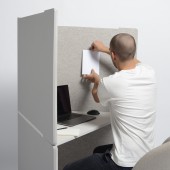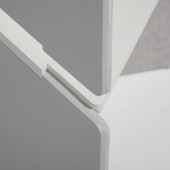Dava Workspace by Michael Strantz |
Home > Winners > #105204 |
 |
|
||||
| DESIGN DETAILS | |||||
| DESIGN NAME: Dava PRIMARY FUNCTION: Workspace INSPIRATION: Open space offices, schools and universities, where quiet and concentrated work phases are important, are often characterised by acoustic and visual stimulus saturation. Great growth, lack of space or lack of rooms often mean that there is no space to withdraw, and so furniture is necessary that is highly flexible in its arrangement and adaptable to changing circumstances. UNIQUE PROPERTIES / PROJECT DESCRIPTION: Dava enables a pleasant work atmosphere by minimizing acoustic and visual disturbances. Due to its triangular shape, the furniture is extremely versatile and allows an optimal use of space and a big variety of arrangement options. OPERATION / FLOW / INTERACTION: A simple plug-in system allows quick and easy storage of the objects. Furthermore, the walls can be removed and used on already existing tables, against visual and acoustic disturbances. The walls can be slid into each other for storage to save space. PROJECT DURATION AND LOCATION: The Project started in September 2018 at the New Design University St. Poelten and was revised in September 2019. FITS BEST INTO CATEGORY: Furniture Design |
PRODUCTION / REALIZATION TECHNOLOGY: For Dava two sustainable and biodegradable materials are used, WPC from Jeluplast and wool felt, both of which are 100% organic and fully compostable. WPC ensures sufficient stiffness and stability and is also relatively light, at 1.1 g/cm3, which ensures easy handling. The material can be applied by injection moulding, which enables cost-efficient production in large quantities. A dove-tail joint, which fixes the two walls to the tabletop, underlines the simplicity in production and handling. This means that no screws or external fasteners are required. SPECIFICATIONS / TECHNICAL PROPERTIES: Width 1285mm x Depth 766mm x Hight 1480mm TAGS: Workspace, desk, wpc, woolfelt, space efficiency, industrial design, table RESEARCH ABSTRACT: The project was entitled YOU for the NDU and the task of this Semesterproject was, to find and define a design problem of the university building and to solve the task appropriately. Through extensive research, the research problem was first defined, which deals with the lack of space to be able to work in seclusion and undisturbed by outer influences. This was followed by the idea generation and design phase, which required both 2-diemensional and 3-dimensional working models. Further steps were detail development, 3D visualisations and the implementation of a prototype on a scale of 1:1. The design phase began in the sketchbook. CHALLENGE: In order to design the product as simple as possible for the user, great value was placed on the best material. Sustainability, feasibility, serial production and affordability played a role in this decision. ADDED DATE: 2020-04-07 12:13:01 TEAM MEMBERS (1) : IMAGE CREDITS: Michael Strantz, 2019. |
||||
| Visit the following page to learn more: https://strantz.myportfolio.com | |||||
| AWARD DETAILS | |
 |
Dava Workspace by Michael Strantz is Winner in Furniture Design Category, 2019 - 2020.· Read the interview with designer Michael Strantz for design Dava here.· Press Members: Login or Register to request an exclusive interview with Michael Strantz. · Click here to register inorder to view the profile and other works by Michael Strantz. |
| SOCIAL |
| + Add to Likes / Favorites | Send to My Email | Comment | Testimonials | View Press-Release | Press Kit | Translations |
Did you like Michael Strantz's Furniture Design?
You will most likely enjoy other award winning furniture design as well.
Click here to view more Award Winning Furniture Design.








